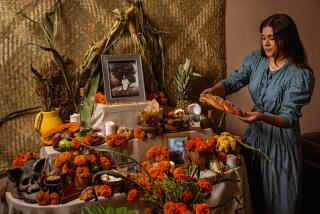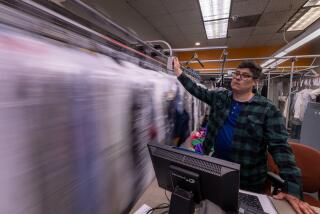SOUTHERN CALIFORNIA ENTERPRISE : Answering a Call for On-Call Autopsies : Professions: Vidal Herrera has found a niche in an industry he says is recession-proof.
Expertly wielding the tools of his trade, Vidal Herrera neatly removed the brain of an Alzheimer’s victim who lay lifeless on a mortuary table. Herrera gingerly placed the brain in an ice-filled container.
Later that day, he would take the brain to a Westside lab where it would be photographed, sliced and frozen in liquid nitrogen for 15 scientists researching Alzheimer’s disease around the world.
Brain removals are all in a day’s work for Herrera, owner and operator of Autopsy/Post Services. The 10-year-old El Sereno business specializes in on-call autopsy assistance and organ removals. It’s a unique niche business that the heavy-set, former coroner’s investigator has carved out of the death industry.
“This is a recession-proof business,” declares Herrera, 43. “Between now and the year 2035 as the baby boomers age, there are going to be a lot of deaths.”
The U.S. Census projects that 20% of the U.S. population--70 million people--will be at least 65 years old by the year 2030, up from 12.5%, or 31 million, in 1990.
Herrera’s business is also founded on another factor: the steady decline in the number of autopsies performed by hospitals in the past 50 years. Fewer than 5% of hospital deaths are routinely autopsied, compared to 50% in the years after World War II.
Herrera performs about 100 private autopsies annually. His customers include relatives of celebrities trying to avoid publicity, family members who want to ensure that the loved one who died overseas and is now buried is truly their relative and others who, for one reason or another, want an autopsy independent of the hospital where the death occurred. His standard fee is $2,000, far less than the $3,500 a hospital might charge. Much of the fee goes to the pathologist, the medical doctor who oversees the procedure.
In addition to private autopsies, he is on call to several hospitals as an autopsy assistant, for which he receives a lower fee. He removes organs from bodies for tissue banks and contracts to do maintenance and supply work with labs at UCLA and at the Veterans Administration Hospital.
While some pathologists have created similar free-lance autopsy businesses in Los Angeles and other parts of the country, Autopsy/Post Services is unique because it was created by someone who is not a doctor. Pathologists, who legally must oversee and sign off on the work, are on call to Herrera.
The arrangement does not sit well with some pathologists--the medical doctors trained to do autopsies--who believe that it leaves the door open for abuses. Autopsy technicians could end up doing most of the work themselves, with a doctor only signing the appropriate documents at the end, said Stephen A. Geller, president of the California Society of Pathologists.
*
But Herrera insists that he strictly observes legal protocols, and Geller, who uses Herrera as an on-call autopsy technician at Cedars Sinai Medical Center, says Herrera is filling a need.
These days pathologists spend most of their time running labs that test human tissue and blood from living patients. Few have the time or interest in performing autopsies, Geller said. And when they do take them on, finding a trained pathology assistant such as Herrera can be difficult.
That helps explain how Autopsy/Post Services has grown from a simple one-person on-call business to three people assisting in 600 autopsies annually, bringing in revenue of $500,000 a year.
“No advertising,” Herrera said. “It’s been all through word-of-mouth.”
And through a lot of media attention.
Herrera is not shy about death or his occupation. His white van, boldly lettered 1-800-AUTOPSY, has been featured in newspaper and magazine articles as well as on TV news shows. He and his assistants wear hospital orderly surgical shirts and pants--all black with a company logo of a brain and skull on the front. He eagerly ferries reporters on his calls.
He recalled one journalist who, after watching him remove seven brains, perform an autopsy and wolf down lamb’s head taquitos for lunch, finally lost his own lunch.
Before he began his business, Herrera, 6-foot-2 with five tattoos, had already earned a reputation in the Los Angeles County coroner’s office. As a Spanish-speaking forensic investigator, he earned the nickname “El Muerto,” or Mr. Death, from Latinos who met him when he was called out on cases.
Even now, the ebullient Herrera relishes his exploits from those days, such as the time he found a fingerprint that helped nail murderer Richard Ramirez, also known as the Night Stalker.
But his career ended in 1980 when he ruptured three disks in his back retrieving the body of a 284-pound suicide victim. Herrera said his recovery from wheelchair to the cane he occasionally uses at the end of a long day took four years. Disabled, he despaired about finding a job, especially after receiving a stinging 84 job-application rejections in one year.
But in 1988 a friend in the coroner’s office called him to free-lance as an autopsy assistant for the county coroner. He began passing out his phone number on scraps of paper, and soon he found himself scrambling to keep up with calls for help.
For a fee, he used to clean up after homicides, fatal accidents and decomposed bodies. But he has since spun off that service to his brother, Gavino, 44, who operates Post Traumatic Clean Ups as a part-time business.
Gavino Herrera said relatives of the deceased, too upset to tidy up the death scene themselves, are usually pleased that the service exists. But the fledgling business has not taken off yet, he conceded.
“It could be a lot busier,” Gavino Herrera said. So far this year, he has cleaned up after fewer than 50 bodies, a tiny number of the more than 60,000 people who die in Los Angeles County each year.
*
A similar death-industry firm has taken off in Baltimore. Crime Scene Clean Up began two years ago serving Washington, D.C.; Maryland; Virginia, and Pennsylvania, said owner Ray Barnes. Like Vidal Herrera, Barnes is a former forensic investigator who saw opportunity where others recoiled.
In addition to crime-scene cleanups, Barnes transports bodies. His business has grown to six employees, and he expects to take in $3.5 million this year.
“Most definitely there’s a growing need,” Barnes said. “Even if the murders level out, there’s still enough to sustain our business with natural deaths.”
Seeing a lucrative future in grim death statistics, Barnes and Herrera plan on franchising their businesses.
But Herrera warns that it’s not for everyone. Only embalmers, forensic investigators, pathologists and autopsy assistants are qualified to run such franchises, he says, as long as they also have business savvy.
Said Herrera, “I’m an autopsy technician, but above that I am a businessman.”
More to Read
Inside the business of entertainment
The Wide Shot brings you news, analysis and insights on everything from streaming wars to production — and what it all means for the future.
You may occasionally receive promotional content from the Los Angeles Times.










